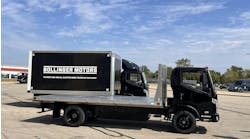I’ve been noticing a lot more intermodal freight lately so I want to step outside my normal focus on Class 8 dry van and reefers and share some thoughts on intermodal chassis and their containers. You know what I am talking about — the tractors hauling intermodal chassis and their shipping containers which have corrugated or ribbed sides to improve durability.
According to testing by Lawrence Livermore National Laboratory, containers with corrugated sides have a significantly higher aerodynamic drag that makes for a rather large fuel economy deficit. I was recently in a Department of Energy meeting where they reported about a 10% fuel economy loss when comparing these types of containers to a smooth sided 53 ft. dry van.
I noticed some other aspects of these intermodal cargo carrying trucks. They can have a very large tractor to container chassis gap. Over the road fleets have been working hard to minimize this gap and keep the air flowing alongside their tractors and trailers. With large gaps many of these vehicles have, the truck engine is basically pulling the entire cross section of the tractor trailer through the air twice. I’ve seem the tractor-trailer gap be as much as 10 to 12 ft. in these applications, and I am guessing that means at lest a 5% deficit in fuel efficiency.
Then there are tires. Intermodal duty cycles are tough. Their journey can begin or end in a rail yard or other distribution center where there is a great deal of debris that can be very damaging to tires. A few large fleets running intermodal have told me that low rolling resistance tires just are not robust enough for these applications. I am seeing about a 5% penalty for the more robust tires,
All that adds up to a pretty big ding to fuel economy. As much as a 20% to 25% loss.
I realize that these trucks don’t get many miles, aren’t always driven at highway speeds and have a very tough life, but that still is a lot of fuel. I don’t have the answer on how to make this situation better, but I know there is a significant opportunity here and I expect as fuel prices go back up, that more freight will move on rail and these intermodal trucks will become even more common. I sure would like to help figure out how to make this better. If you want to kick some ideas around give me a call because with these kinds of trailers we’ve got miles to go before they are truly fuel efficient.



